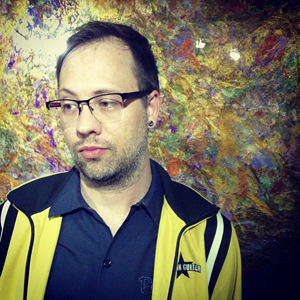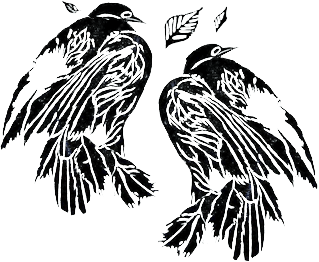The young couple is discordant—two blue shirts
making out among the shuffle of art-grazers
(an ocean of eyes). At the exhibit’s entrance, a dome
of aluminum cups and plates throws circles of light
on the floor. A stone Buddha sits in meditation
against the south wall. His ears (stretched to his hips)
forgive the couple’s smacking. Enshrined in the pillar
at the center of the room, a bronze Kali
dances in her glass case. The faux marble
(a shade of forest) suggests the smoldering foreplay could
incinerate the room should the dark mother declare
the décor is all wrong. Gold-gilt, Shiva turns his gaze
to witness Atman’s divine drama in the kissing-
corner where the teenage pair awaken
to the averted eyes of more modest patrons, and flee
the India room. Ambling arm-in-arm through the Sikh exhibit,
they self-consciously quiet their petting. They pause
before a stack of glass pages, each one quarter-inch thick,
each frosted with a line of Punjabi. The Dasam Granth,
stenciled across their reflections, reveals their place
among scripture. Vāhigurū, watching from his shrine,
blesses all visitors. Blown glass vials
(bodies stained with vortices of yellows, blues,
pinks and purples) whisper contain yourselves, do not disturb
the silence. From their wood canvases, the Ten Gurus
guide the lovers to a shower of silver strands
polished with fragments of Vāhigurū’s glyph (disappearing,
reappearing with each turn through the room). Leaving
the exhibit, the teens rekindle their coital prelude
among the Abstract Expressionist Americans. Mark Tobey’s
haphazard whorls of white, blue and yellow tempera
(scribbled across their 5’x8’ cardboard
canvas) stoke the couple’s groping. Across
the open-air labyrinth, Cy Twombly’s
three frenetic buttons of purple and magenta
bloom against their powder blue plywood
backdrop, the passionate petals (messy,
circular squiggles) lather the lovers’
public lovemaking. And before
Jasper Johns’s three layers
of encaustic America,
their mobile installation
erupts through the silence:
Our lives will end tomorrow.
 Scott Chalupa lives and writes in an attic apartment with doorjambs barely tall enough for head clearance. A winner of the Howard Moss Poetry Prize, he served on the nominating committee for the 2014/15 Houston Public Poetry series. He is currently pursuing an MFA in poetry at the University of South Carolina in Columbia. His work has appeared/is forthcoming in several venues, including Houston NPR, The Allegheny Review, Houston & Nomadic Voices, and Dark Matter.
Scott Chalupa lives and writes in an attic apartment with doorjambs barely tall enough for head clearance. A winner of the Howard Moss Poetry Prize, he served on the nominating committee for the 2014/15 Houston Public Poetry series. He is currently pursuing an MFA in poetry at the University of South Carolina in Columbia. His work has appeared/is forthcoming in several venues, including Houston NPR, The Allegheny Review, Houston & Nomadic Voices, and Dark Matter.
